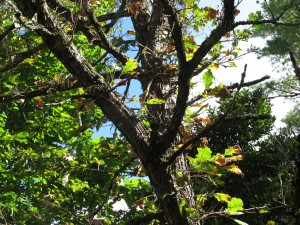Bur oak or mossycup oak (Quercus macrocarpa), aka blue oak and mossy overcup oak, is a majestic native oak native to the midwest and eastern U.S. (USDA hardiness zones 3-8). It a member of the white oak group (rounded leaf lobes, no bristly tips). This large sized deciduous oak grows 60-80 feet tall with a broad-spreading, rounded crown at maturity. Specimens over 90 feet tall are not hard to find. This large shade tree is most suited to large residential and commercial properties, golf courses, or parks.
The tree tends to be slow-growing, particularly when first planted. It naturally grows in deep prairie well-drained soils and in full sun. It adapts to a wide range of soil conditions, including bottomlands. Bur oak is often seen growing in calcareous (limestone) upland soils and is remarkably drought resistant. It is relatively intolerant of flooding.
Strings of yellowish-green separate male and female catkin flowers appear in spring as the leaves are emerging. Leaves are dark green and leathery, 6-12 inches long, and 5-9 rounded lobed. In fall leaf color turns a blah yellow-brown. By late September most leaves have often dropped due to secondary disease and past problems. Twigs and the main branches are often ridged with corky wings.
It may take 35 or more years to produce its first acorn crop. Large sized mossy cup acorns, almost 2 inches long, are oval shaped, and fringed by a burry cup that covers 1/2 to 3/4 of the acorn length. Acorns are an important fall-winter food source for wildlife. Acorns (nuts) have low tannin toxicity; it is best to leached or boiled out the tannins prior to consuming lots of them. Its wood is highly valued like white oak (Q. alba).
Bur oak is a long-lived low-maintenance tree. It is susceptible to numerous secondary diseases, none of which seriously injure the tree. It is resistant to dreaded oak wilt (Ceratocystis fagacearum) disease. Troublesome insect pests include scale, oak skeletonizer, leaf miner, galls, oak lace bugs, borers, caterpillars and nut weevils. Bur oak tolerates urban pollution better than most oaks.


 Posted in
Posted in 
